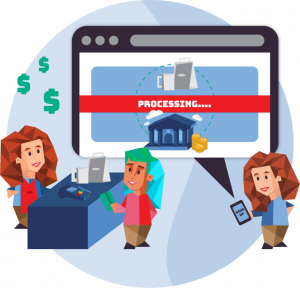Credit Card Chargebacks
Learn How to Manage Chargebacks Like a Pro
One day your customer pays you with a credit card, and the next they’re asking their card issuing bank (not you) to refund the payment. That’s a chargeback, a payment dispute, a forced refund. It means your business loses its money and then some in the form of a chargeback fee.
You’re gonna hate chargebacks. Every business does. But chargebacks come with the territory when you accept credit card payments at your business, so it helps to understand how chargebacks work, how and when to fight them, and how to prevent as many chargebacks as you can.

Credit Card Chargebacks:
What You'll Discover Below
Payment Processing 101
Chargebacks are an unfortunate fact of life in payment processing, but understanding what they are and how to dispute them can help you protect your business from these losses.
Want to know more about payment processing as a business owner? Click the button below to access our paymentprocessing guide.
What is a Chargeback?
A chargeback is a payment dispute initiated by your customer’s card issuing bank (the bank that issued your customer’s credit card), usually at the customer’s request.
Chargebacks reverse credit card payments that were already authorized and settled, such that the funds for the payment get debited from your business’s merchant account and transferred back to your customer’s issuing bank.
The purpose of chargebacks
Chargebacks are a tool consumers can use to protect themselves. In this sense, chargebacks are a positive thing. Since the credit card payment process is automated, it’s only sensible that a corresponding automated refund process exists as well.
Some common reasons for chargebacks include:
- Billing errors: As when a merchant charges a consumer an incorrect price (a price that differs from the price the consumer agreed to pay).
- Defective products: As when a merchant ships a consumer a product that doesn’t look or function in the way it was advertised or in the way the consumer expected (perhaps because it was damaged during delivery, or because the consumer misread the product’s advertisement).
- Fraud/identity theft: As when a third-party fraudster obtains the consumer’s card or bank account information and uses it to make an unauthorized purchase (a major reason merchants pay more for online credit card processing).
- Merchant fraud: As when a merchant deliberately misleads a consumer into purchasing a product (e.g., through misleading advertising or shipping counterfeit products).
Legitimate vs. illegitimate chargebacks
Billing errors, truly defective products, identity theft, and merchant fraud—these are all legitimate reasons why a consumer shouldn’t be held responsible for payments made with their credit cards.
To the extent that the consumer’s claim is accurate, there’s no good reason for your business to try to fight back against the chargeback request (and if you’re truly committing merchant fraud—well, that’s another thing entirely).
Of course, many chargebacks—even when they seem legitimate to the consumer—can be ambiguous (and, no, the customer is not always right). From simply failing to recognize a charge to not liking a product that otherwise functions as advertised to intentional fraud on the part of the consumer, some consumers will dispute a credit card payment for reasons completely beyond a merchant’s control.
Can my business dispute a chargeback?
Yes. At least if you have a good case to make against the chargeback, and have the evidence available to prove your case. The process for merchants to dispute chargebacks is called representment, and we will cover that process in detail below.
Just in keep mind that the card payment industry heavily favors consumers whenever a merchant tries to fight back against a chargeback. Not only will you need to prove your case, but you’ll need decide if it’s worth your time and money.
How the Chargeback Cycle Works
When a cardholder requests a chargeback from their issuing bank, the chargeback goes through a fairly well-defined process. There are 4 basic steps to the credit card chargeback cycle:
This is the stage at which your customer submits a chargeback request to their card issuing bank. Ideally, the customer would have contacted your business first to try to resolve the dispute—and most issuing banks want them to do so—but this isn’t a universal practice, and not all consumers will bother anyway (particularly if the chargeback isn’t legitimate).
In any case, the issuing bank will expect your consumer to provide an explanation for the chargeback—an explanation the bank will translate into a “reason code” provided by the card brand used (Visa, MasterCard, and so on).
The rules governing particular chargeback requests can vary depending on the reasons behind the request.
To identify those rules, your customer’s card issuing bank matches the chargeback request with a “reason code” that defines the type of evidence your business has to submit if you want to dispute the chargeback.
The issuing bank then evaluates the chargeback request. If the issuer determines that the chargeback is clearly illegitimate, the issuer will decline the chargeback request and the process comes to an end without your business losing any money in the process. (In fact, you’ll probably never hear anything about the chargeback request.)
However, if the issuing bank approves the chargeback request (as they usually will), it will notify your payment processor and/or acquiring bank, which will reverse the transaction and transfer the funds for the payment from your merchant account to your customer’s issuing bank. So, you’ll lose the funds from the original payment and pay a chargeback fee assessed by your payment processor along the way.
Once you’re notified of the chargeback through your acquiring bank or payment processor, you’ll have a certain number of days to respond—a time-frame that can vary depending on the card brand and the chargeback code the issuing bank assigns to the chargeback. You’ll typically be notified of the appropriate time-frame when you’re notified of the chargeback, but contact your payment processor immediately if you aren’t sure.
If you know the chargeback is warranted, simply accept it, learn from it, and move on. Concentrate instead on adjusting your business practices to prevent as many chargebacks as you can.
However, merchants will often accept chargebacks they don’t consider legitimate if the transaction amount isn’t high enough to justify the time spent disputing it. In that case, keep in mind that “accepting” a chargeback isn’t the same thing as officially acknowledging that your customer’s claim is accurate. Agreeing and not bothering to disagree are two different things in the card payment industry.
Chargeback Fees
Most every payment processor will charge your business a chargeback fee for every chargeback you receive, ranging typically from between $15 and $25 for each chargeback, though chargeback fees can be much higher (as high as $100 in some cases) depending on the processor you choose.
Note that chargeback fees are essentially service fees covering administrative costs, so even if you successfully dispute a chargeback, you won’t get the money back from the chargeback fee you paid to your processor. Nor will you get back the credit card processing fees you paid for the original credit card payment.
Sound a little unfair? You bet. Every facet of the chargeback process has a negative impact on merchants, which is why the best strategy is always to prevent as many chargebacks as you can.
Chargeback Representment (Disputing a Chargeback)
Chargebacks are part of the cost of accepting credit card payments at your business, but that doesn’t mean you have to roll over and accept every chargeback that comes your way.
The process for disputing a chargeback—called representment because you “re-present” the charge—is still available to you. If you win your representment, you’ll get the funds back for the original transaction. However, you won’t get back the money you lost on chargeback fees and other administrative costs associated with the representment you filed.
In general, you’ll only want to dispute a chargeback if the following is true:
- You’re pretty sure the disputed transaction was legitimate (even if the consumer is sincere in their mistaken view).
- You can provide clear, compelling evidence to support your claim—evidence that corresponds to the requirements for the reason code given to the chargeback.
- The amount of the transaction is high enough to justify the time spent gathering evidence and working through the representment process.
Of course, some merchants will fight illegitimate chargebacks on principle, even if the costs don’t seem worth it. Whether your business chooses to go that route is up to you.
Here’s how chargeback representment works:
When you’re notified of a chargeback, that notification will include a reason code that is essentially a categorization of the explanation your customer gave their issuing bank for why they want to dispute the charge. As such, fighting the chargeback requires you to provide evidence against your customer’s dispute that fits this reason code. This is generally called gathering “compelling evidence.”
What counts as compelling evidence varies by reason code. For example, if the code sites an “incorrect amount” as the reason for the chargeback, you might need to show that the price you charged was the correct one at the time of sale, that the price was accurately advertised, and that the customer consented to the price by signing a receipt or otherwise authorizing the transaction.
A chargeback rebuttal letter is a summary of why your customer’s chargeback request isn’t valid. The goal of the letter is to clearly explain the situation, explain why the evidence you’ve gathered shows that the chargeback is illegitimate, and clearly state the result you want (i.e., that you want to overturn the dispute).
Since a chargeback rebuttal letter is essentially a cover letter introducing the compelling evidence you’ve gathered against the chargeback, you’ll send it alongside that evidence (screenshots, copies of receipts, and so on—whatever the case may be).
Note that you won’t deal directly with your customer’s card issuing bank. Your acquiring bank or payment processor will submit your representment for you, which means you’ll want to adhere closely to whatever guidelines your acquirer or payment processor has in place for the representment process.
Once you submit the appropriate documentation through your acquirer or payment processor, your customer’s issuing bank will evaluate the evidence. If the issuing bank believes your evidence against the chargeback is valid, the funds from the transaction will be returned to you. If not, the chargeback will stand, and the matter will be (typically) closed.
Note that if you lose your representment, it remains possible to dispute the issuing bank’s decision by getting the card network involved. This process is called arbitration, and it rarely works out in the merchant’s favor.
Chargeback Monitoring Programs
If your business starts receiving a lot of chargebacks consistently, you’ll likely land in a chargeback monitoring program of some kind. Chargeback monitoring programs are basically probationary programs handled by the card brands, like Visa and MasterCard, which kick in when a merchant’s chargeback-to-sales ratio consistently passes a certain threshold (this can be as low as 1% of your overall sales for Visa).
The details vary from card brand to card brand, but the basic idea is always the same. When your business has a high chargeback-to-sales ratio, the card brands see your business as a high risk, and they want that to change. You’ll be watched closely and expected to take concrete steps to reduce the number of chargebacks your business receives. Otherwise, your business may lose the right to process credit card payments altogether.
Ways to Prevent Chargebacks
You aren’t likely to successfully dispute most chargebacks. The chargeback process is heavily weighted in favor of consumers, so ambiguous cases—cases where outright fraud isn’t at issue and the terms of the dispute are open to debate—are likely to be decided in your customer’s favor.
As such, successfully fighting back against chargebacks tends to be less important than preventing as many chargebacks as you can. Doing so can save your business money on chargeback fees, help you avoid the need to dispute a chargeback, and create better business practices overall.
Though you aren’t likely to avoid dealing with chargebacks all together, here are three preventative steps you can take to reduce the number of chargebacks your business receives:
Although good customer service won’t prevent every chargeback, it’s the most tried-and-true method (and the cheapest method) there is. This is because customer dissatisfaction is at the heart of many chargebacks, and a dissatisfied customer is far more likely to try to resolve a dispute with you directly if they perceive your business to be available and attentive to their needs.
Make sure your customer service line is prominent on your website. Make sure the phone-line is covered and answered promptly. Craft clear policies and display them clearly on your website. If you offer subscription services, make it easy to cancel.
And, above all, don’t oversell yourself because this can lead to excessively high expectations on the part of your customers. There’s a fine line between hyping your products or services and exaggerating what your business can do for consumers, but there is little to gain, in the long run, from setting your business up to fail.
Visa, MasterCard, Discover, and American Express each have rules for how transactions using their branded cards should be handled. For transactions involving swiped cards and signatures, for example, you might be required to verify the signature by looking at the back of the card. For online transactions, you might be required to capture the customer’s IP address or use CVV verification.
If you follow these rules, you’ll be in a position to prevent many fraudulent transactions from ever happening in the first place, and you’ll be in a better position with the card network if you decide to dispute a chargeback. Ignore these rules, and you might find an issuing bank ruling against your representment right away.
It’s common for customers to make a payment in good faith and then not recognize the payment when it appears in their bank account—often because a business doesn’t use an easily identifiable merchant descriptor. Then the customer submits a chargeback request because they think a fraudster got ahold of their card information.
To prevent this, make sure your merchant descriptor clearly identifies your business. For example, if you form an LLC using one name for your legal entity but do business under a different name (a DBA), make sure your merchant descriptor includes the DBA.
You might also include a working phone number as part of your merchant descriptor. That way, if a merchant doesn’t recognize your business, they’ll have a number to call to inquire about the charge in advance of submitting a chargeback request.
Credit Card Chargebacks FAQs
The typical range is fairly uniform across card brands—roughly between 60 and 120 days after the date of the purchase depending on the reason code for most chargeback requests.
After a chargeback has been submitted by an issuing bank, the merchant has a time period (fixed by the card brand) for disputing the chargeback. For Visa, it’s 30 days. For MasterCard, it’s 45 days. For American Express, it’s 20 days. For Discover, it’s 30 days.
Yes, at least with most card brands. In the card payment industry, ignoring a chargeback is typically the same thing as accepting a chargeback. However, Visa will fine merchants who don’t respond to a chargeback within the allotted time-frame (usually 30 days). That is, your business can accept the chargeback within 30 days or takes steps to represent the chargeback within 30 days, but you have to respond one way or another.
Yes, and the chargeback process is fundamentally the same for debit cards as it is for credit card payments.
Chargebacks are always a loss for merchants when it comes to chargeback fees and the loss of funds from an already settled payment.That said, a business can learn a lot from chargebacks. If, for instance, your business receives a high number of chargebacks for a subscription service because your customers can’t easily cancel their subscriptions, you might discover that your cancellation process is too difficult or obscure. This discovery can help you refine your business practices to prevent many chargebacks in the future.
Your business’s chargeback ratio is your number of chargebacks divided by the number of transactions your business processed in a given month. This ratio gets used by card networks and payment processors to determine if a merchant has too many chargebacks by industry standards. A chargeback ratio of 1% or greater is generally considered “high” by the industry.
It’s probably more helpful to speak of a “range” for chargeback fees than an average. Chargeback fees can range anywhere between around $15 to $100 depending on your payment processor and your business’s processing history. If a merchant receives a lot of chargebacks consistently, some payment processors will penalize the merchant by its chargeback fees.
Typically, no. Chargeback fees are really just your payment processor’s administrative fees for handling chargebacks, so even if your business submits a representment and wins, you won’t the money back from the chargeback fee your business paid.





